I talk about home grown food being tastier and healthier. This is mainly due to the assumption, that chemicals such as pesticides and herbicides, used in large scale farming, are present in the food we buy from the supermarket.
But what if it was more than that?
What if food that we grew at home was actually packed full of more nutrients and minerals?
Thanks to the dilution effect, this is most likely to be the case. Observations show that crops with higher yields (eg large and plentiful tomatoes) tend to have lower nutrient percentages than those with lower yields. The dilution effect assumes that plants have a limited ability to take up nutrients. When yields are increased, these limited nutrients are diluted throughout the larger yield. It is now thought that dilution effects can be caused by both environmental and genetic influences (more on that here).
Seed selection is the most critical aspect of growing nutrient dense food.
Testing for nutritional values requires expensive, sophisticated equipment. But, what if there was a relatively simple way to test this?
Good news, there is!
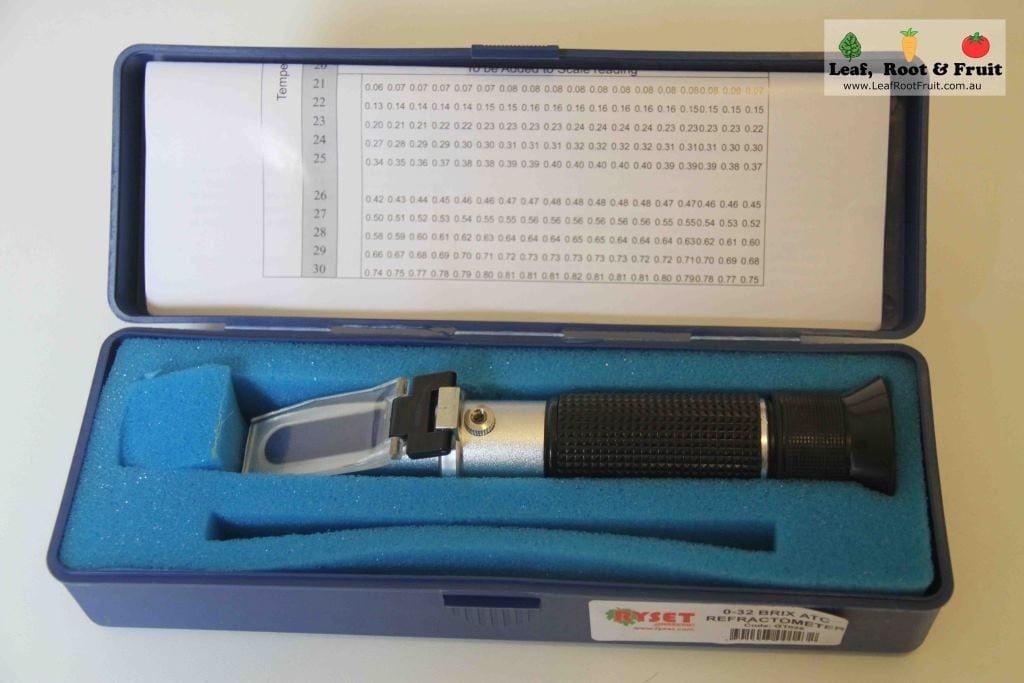
Ideally, we would all have access to expensive spectrophotometers to measure the nutrient density of plants. Unfortunately, that’s not possible. The next best thing is a refractometer such as this little device. You can purchase a decent one for between 100 and 200 dollars. It’s small, so you can take it anywhere and is easy to use. Refractometers are used in the horticulture industry to determine the optimum time to pick grapes and other fruit.
Correlation of Brix and nutrient density of vegetables
A refractometer measures “Total Suspended Solids”. TSS is measured in the unit “Brix” after Professor Adolf Ferdinand Wenceslaus Brix. He was a 19th Century German chemist (1798-1890) and was the first to measure the density of plant juices.
TSS refers to the total amount of soluble constituents of the extract. These are mainly sugars, with smaller amounts of organic acids, vitamins, proteins, free amino acids, essential oils and glucosides. TSS is an excellent guide to the sugar content of fruit and vegetables and sugar content is generally correlated with the nutrient density.
Correlating TSS to Nutrient Density has its critics (and limitations). In fact, there is no robust scientific evidence that high Brix correlates with high nutrient density (despite what many websites out there will tell you). However, it is becoming more accepted as a fast and reliable way to assess nutrient density. The basic premise of this correlation, is that plants producing food rich in sugars, also produce nutrient dense food. Comparisons of Brix to more complex measurement techniques have found a strong correlation. Work is continuing in this area, but so far, crops with higher Brix are shown to be:
- Sweeter tasting
- More nutritious
- Lower in water and nitrate content
- Have a lower freezing point (so therefore have better frost protection)
- Have longer shelf-life
Dr Carey Reams pioneered a lot of this work and he developed a table to compare the quality of fruit and vegetables, to their respective of Brix values.
How does a refractometer work?
A refractometer works much like a prism. Prisms separate out the different wavelengths of light (red, orange, yellow, green, blue, indigo, violet), when a source of light is shone on it, at the correct angle? A refractometer works on the same principle. It reacts differently to light (by giving a reading on a scale), depending upon the amount of Total Soluble Solids (TSS) that is available, in the liquid sample being tested. The unit of measurement for TSS measured using a refractometer is “Brix”
The higher the Sugar and TSS content, the higher the Brix reading.
How do you measure Brix in vegetables?
Measuring Brix in vegetables, using a refractometer is very simple. You’ll need the following equipment:
- Refractometer
- Garlic Press
- Distilled (or de-ionised water)
- Eye dropper
- Small Bowl
- Knife to cut up samples
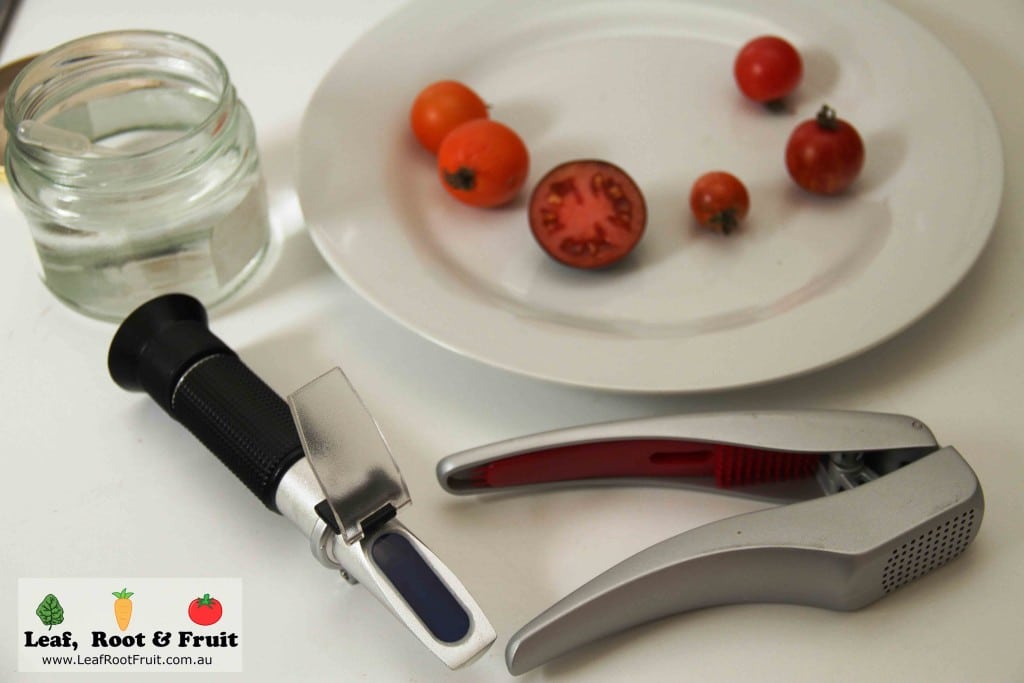
All the equipment should be clean, free from dust and dirt. The equipment should be cleaned between measurements, to ensure that your readings are accurate and not contaminated by previous readings.
The best garlic press to use for extracting your plant juice is a Zyliss brand garlic press. All other garlic presses tend to break after a short amount of time.
Method for measuring brix
- Calibrate your refractometer using distilled/de-ionised water as per the manufacturer’s directions.
- Crush your sample in the garlic press and extract the juice into the bowl.
- Use the eye dropper to place a few drops of the vegetable extract onto the refractometer window
- Close the cover and hold the refractometer up to your eye, directed towards a strong light source (eg a window)
- Read the Brix measurement through the eye piece. The reading should be taken where the blue and white spaces intersect.
- Wash all the equipment thoroughly before taking your next measurement
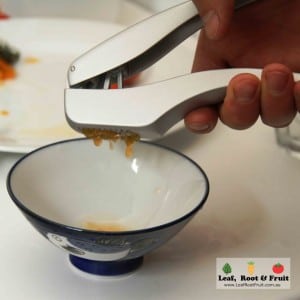
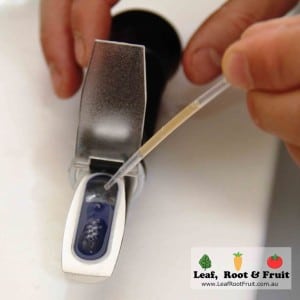
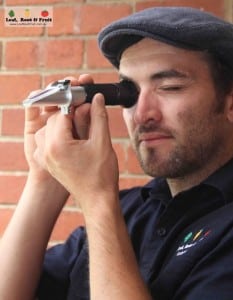
Repeat measurements
I’ve already noticed a slight variation in measurements for the same fruit sample. It’s understandable that if you are extracting the juice, from say a tomato, that different parts of the fruit will produce slightly different results. So in the interests of obtaining measurements that are as accurate as possible, I am taking three measurements from each extraction and averaging them. The refractometer is cleaned between each measurement.
My aim to measure Brix in home-grown produce
Now that I have the tools required to measure the Brix, I intend to put them to good use. I’m going to measure as much produce as I can. I’ll keep a record of the measurements in an excel spreadsheet. That will allow me to look for trends and do some statistical correlations between various factors. I’m hoping to see some trends and work out if there are differences between say wicking beds and growing veggies in the ground. I’m also keen to see if there are differences between Brix measurements for different plant varieties (I’m already noticing large differences between different tomato varieties).
What will I be able to compare with the Brix measurements?
This is only limited by my imagination but here are a few ideas that I want to compare:
- Different varieties or cultivars of the same vegetable
- Home grown produce vs store bought produce
- Food grown in wicking beds vs raised garden beds vs in the ground vs pots
- Different fertilising regimes (regular liquid feeds vs slow release vs seasonal addition of compost only)
- Different planting times of the year and how herbs and leafy greens are affected.
- Different soil types
- Vegetables grown in full sun vs partial shade.
I’m really looking forward to incorporating Brix measurements into my gardening. I’m a firm believer that anything that you measure tends to improve over time. That way, my family can eat food that is as tasty and nutrient dense as possible!
Have you had much experience with measuring Brix of your produce? Please share any thoughts or advice on this topic in the comments section below.
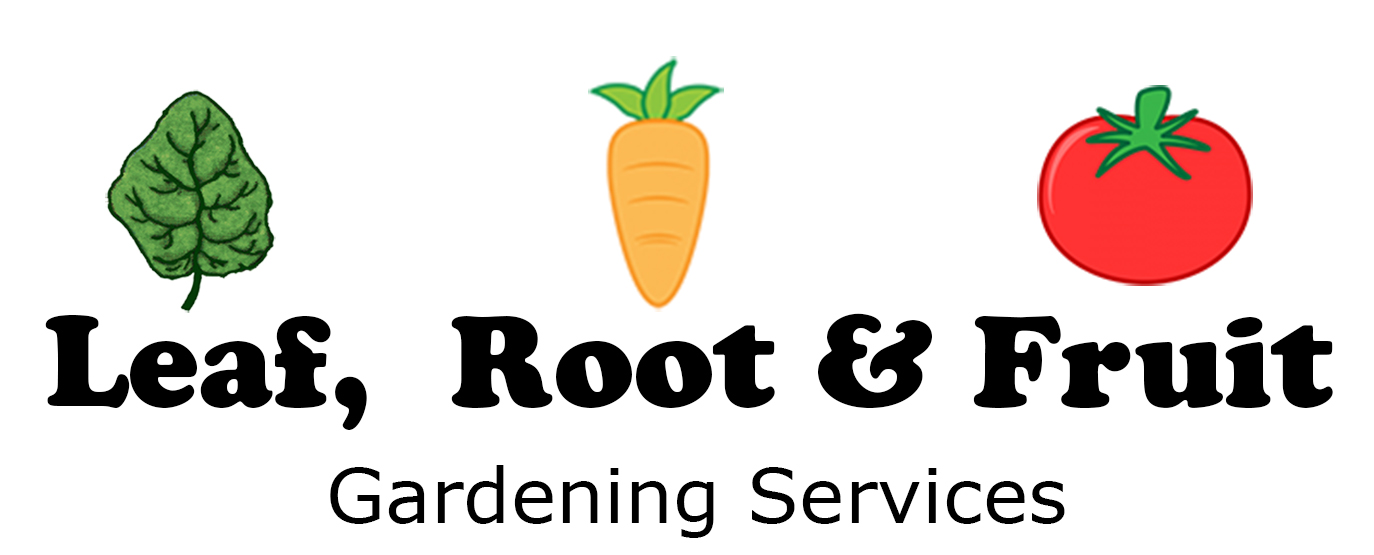


Thanks very much for the interesting article Duncan – saw one of these in an Op Shop and was curious. Just wondering if you managed to do many of these measurements and found interesting things or if time got too busy.
Hi Jon, yes we have found out quite a few interesting trends and observations through using our refractometer. We particularly use it with tomatoes to look at how different varieties and soil types can influence the results. For those who are interested in learning more about refractometers the March workshop in The Science of Edible Gardening series covers the use of these and includes some tomato taste tests!
Thanks Duncan